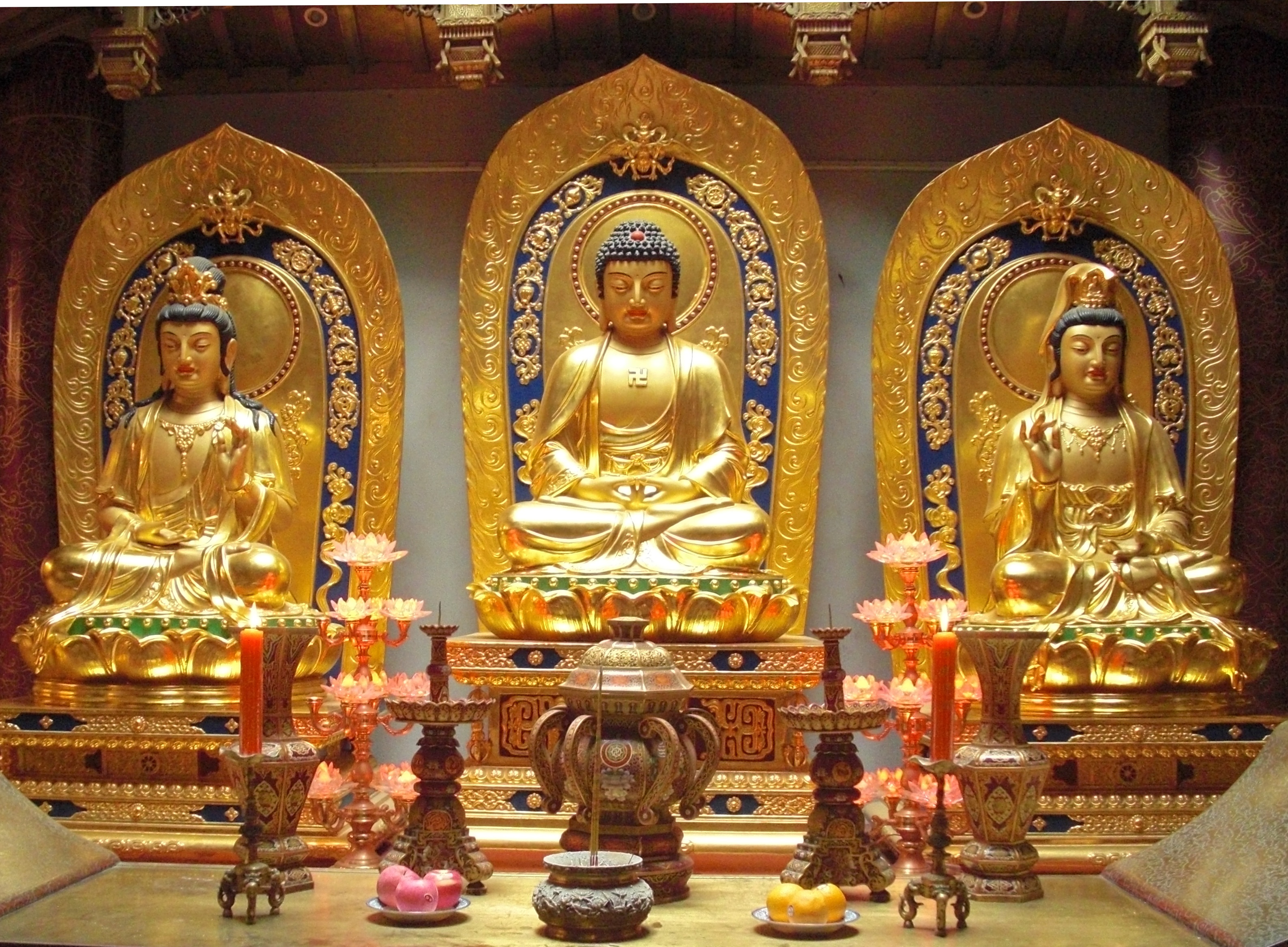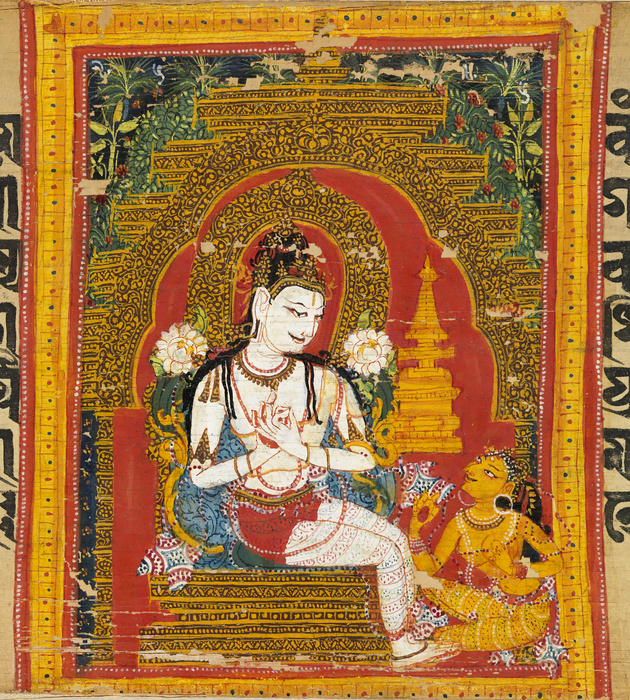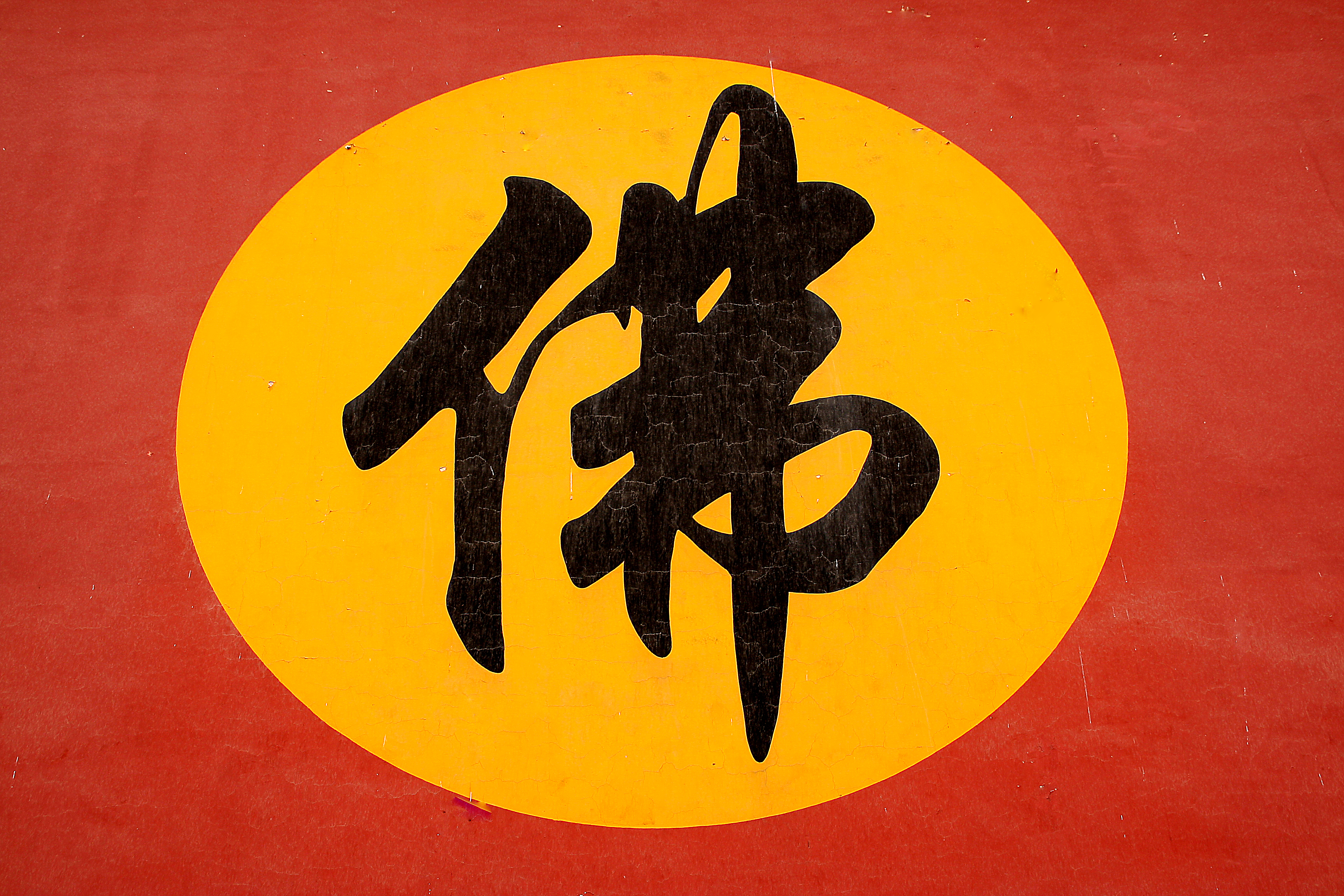|
Tiantai
Tiantai or T'ien-t'ai () is an East Asian Buddhist school of Mahāyāna Buddhism that developed in 6th-century China. Drawing from earlier Mahāyāna sources such as Madhyamaka, founded by Nāgārjuna, who is traditionally regarded as the first patriarch of the school, Tiantai Buddhism emphasizes the "One Vehicle" () doctrine derived from the influential '' Lotus Sūtra'', as well as the philosophy of its fourth patriarch, Zhiyi (538–597 CE), the principal founder of the tradition. Brook Ziporyn, professor of ancient and medieval Chinese religion and philosophy, states that Tiantai Buddhism is "the earliest attempt at a thoroughgoing Sinitic reworking of the Indian Buddhist tradition." According to Paul Swanson, scholar of Buddhist studies, Tiantai Buddhism grew to become "one of the most influential Buddhist traditions in China and Japan." Tiantai is sometimes also called "The Dharma Flower School" (), after its focus on the '' Lotus Sūtra'', whose Chinese title tra ... [...More Info...] [...Related Items...] OR: [Wikipedia] [Google] [Baidu] [Amazon] |
Tendai
, also known as the Tendai Dharma Flower School (天台法華宗, ''Tendai hokke shū,'' sometimes just ''Hokkeshū''), is a Mahāyāna Buddhist tradition with significant esoteric elements that was officially established in Japan in 806 by the Japanese monk Saichō. The Tendai school, which has been based on Mount Hiei since its inception, rose to prominence during the Heian period (794–1185). It gradually eclipsed the powerful Hossō school and competed with the rival Shingon school to become the most influential sect at the Imperial court. By the Kamakura period (1185–1333), Tendai had become one of the dominant forms of Japanese Buddhism, with numerous temples and vast landholdings. During the Kamakura period, various monks left Tendai to found new Buddhist schools such as Jōdo-shū, Jōdo Shinshū, Nichiren-shū and Sōtō Zen. The destruction of the head temple of Enryaku-ji by Oda Nobunaga in 1571, as well as the geographic shift of the capital away from ... [...More Info...] [...Related Items...] OR: [Wikipedia] [Google] [Baidu] [Amazon] |
Zhiyi
Zhiyi (; 538–597 CE) also called Dashi Tiantai (天台大師) and Zhizhe (智者, "Wise One"), was a Chinese Bhikkhu, Buddhist monk, Buddhist philosophy, philosopher, meditation teacher, and Exegesis, exegete. He is considered to be the founder of the Tiantai Buddhist tradition, as well as its fourth Patriarch (Buddhism), patriarch. Śramaṇa Zhiyi is widely regarded as one of the most influential figures in the development of East Asian Buddhism, East Asian Buddhist thought and practice. As the first major Chinese Buddhist thinker to construct a comprehensive religious system based primarily on Chinese interpretations, Zhiyi played a crucial role in synthesizing various strands of Mahayana Buddhism into a unique coherent framework."Tiantai Zhiyi." In ''The Princeton Dictionary of Buddhism'', 911–12. Princeton University Press, 2014. http://www.jstor.org/stable/j.ctt46n41q.27. According to David W. Chappell, Zhiyi "has been ranked with Thomas Aquinas and al-Ghazali as one o ... [...More Info...] [...Related Items...] OR: [Wikipedia] [Google] [Baidu] [Amazon] |
Zhanran
Jingxi Zhanran (; J. Keikei Tannen; K. Hyŏnggye Tamyŏn, c. 711-782) was the sixth patriarch of the Tiantai school of Chinese Buddhism. Zhanran is considered to be the most important Tiantai figure after the founder Zhiyi."Zhanran", in Silk, Jonathan A. et al. ''Brill’s Encyclopedia of Buddhism'': Volume II: Lives, pp. 814-817. He was also called Master Miaole (Sublime Bliss), Dharma Master Jizhu (Lord of Exegesis), and Jingqi (荊溪) after his birthplace. Zhanran helped to define, defend and popularize the Tiantai tradition during the Tang, developing its doctrinal system further by building on Zhiyi's writings. Zhanran wrote some important commentaries on Zhiyi's works as well as original treatises of his own. He is also the first figure to use the term "Tiantai School" (Tiantai zong). Life Zhanran was born in Jingqi (荊溪), in modern-day Yixing 宜興 county, Jiangsu province. His lay surname was Qi (戚). After receiving a Ruist (Confucian) education, Zhanran became ... [...More Info...] [...Related Items...] OR: [Wikipedia] [Google] [Baidu] [Amazon] |
Pure Land Buddhism
Pure Land Buddhism or the Pure Land School ( zh, c=淨土宗, p=Jìngtǔzōng) is a broad branch of Mahayana, Mahayana Buddhism focused on achieving rebirth in a Pure land, Pure Land. It is one of the most widely practiced traditions of East Asian Buddhism, Buddhism in East Asia. It is also known as the "Lotus School" (Chinese language, Chinese: 蓮宗; pinyin: ''Liánzōng'') in China or the "Nianfo, Nembutsu school" in Japan. East Asian Pure Land mainly relies on three main Mahayana sutras, Mahayana scriptures: the ''Longer Sukhāvatīvyūha Sūtra, Sutra of Amitayus'', the ''Amitāyus Contemplation Sūtra, Contemplation Sutra'' and the ''Shorter Sukhāvatīvyūha Sūtra, Amitabha Sutra''. The Pure Land tradition is primarily focused on achieving rebirth in a Buddhahood, Buddha's "pure land", a superior place to spiritually train for full Buddhahood, where one can meet a Buddha face to face and study under them without any of the distractions or fears of our world.Williams, Pau ... [...More Info...] [...Related Items...] OR: [Wikipedia] [Google] [Baidu] [Amazon] |
Tiantai Mountain
Tiantai Mountain (also Tí Taî in the local language) is a mountain in Tiantai County, Taizhou, Zhejiang Province, China. Its highest peak, Huading, reaches a height of . The mountain was made a national park on 1 August 1988. One of nine remaining wild populations of Seven-Son Flower ('' Heptacodium miconioides'') is located on mount Tiantai. Legends In the mythology of Traditional Chinese religion, the creator goddess Nüwa cut the legs off a giant sea turtle () and used them to prop up the sky after Gong Gong damaged Mount Buzhou, which had previously supported the heavens. A local myth holds that Tiantai was on the turtle's back before and Nüwa relocated it to its current position when she had to remove the turtle's legs. Guoqing Temple Guoqing Temple on the mountain is the headquarters of Tiantai Buddhism, and also a tourist destination. Tiantai, named for the mountain, is an East Asian Buddhist school of Mahāyāna Buddhism that developed in 6th-century Chi ... [...More Info...] [...Related Items...] OR: [Wikipedia] [Google] [Baidu] [Amazon] |
Lotus Sutra
The ''Lotus Sūtra'' (Sanskrit: ''Saddharma Puṇḍarīka Sūtram'', ''Sūtra on the White Lotus of the True Dharma'', zh, p=Fǎhuá jīng, l=Dharma Flower Sutra) is one of the most influential and venerated Buddhist Mahāyāna sūtras. It is the main scripture on which the Tiantai along with its derivative schools, the Japanese Tendai and Nichiren, Korean Cheontae, and Vietnamese Thiên Thai schools of Buddhism were established. It is also influential for other East Asian Buddhist schools, such as Zen. According to the British Buddhologist Paul Williams, "For many Buddhists in East Asia since early times, the ''Lotus Sūtra'' contains the final teaching of Shakyamuni Buddha—complete and sufficient for salvation." The American Buddhologist Donald S. Lopez Jr. writes that the ''Lotus Sūtra'' "is arguably the most famous of all Buddhist texts," presenting "a radical re-vision of both the Buddhist path and of the person of the Buddha." Two central teachings ... [...More Info...] [...Related Items...] OR: [Wikipedia] [Google] [Baidu] [Amazon] |
Chinese Buddhism
Chinese Buddhism or Han Buddhism ( zh, s=汉传佛教, t=漢傳佛教, first=t, poj=Hàn-thoân Hu̍t-kàu, j=Hon3 Cyun4 Fat6 Gaau3, p=Hànchuán Fójiào) is a Chinese form of Mahayana Buddhism. The Chinese Buddhist canonJiang Wu, "The Chinese Buddhist Canon" in ''The Wiley Blackwell Companion to East and Inner Asian Buddhism'', p. 299, Wiley-Blackwell (2014). draws from the traditions of Confucianism and Taoism as well as the rituals of local Chinese folk religion, folk religions. Chinese Buddhism emphasizes the study of Mahayana sutras and treatises. Some of the most important scriptures in Chinese Buddhism include the ''Lotus Sutra'', ''Avatamsaka Sutra, Flower Ornament Sutra'', Vimalakirti Sutra, ''Vimalakirtī Sutra'', ''Mahāyāna Mahāparinirvāṇa Sūtra, Nirvana Sutra,'' and Shorter Sukhāvatīvyūha Sūtra, ''Amitābha Sutra''. Chinese Buddhism is the largest institutionalized religion in mainland China.Cook, Sarah (2017). The Battle for China's Spirit: Religious R ... [...More Info...] [...Related Items...] OR: [Wikipedia] [Google] [Baidu] [Amazon] |
Cheontae
Uicheon, the founder of the Korean Tiantai school Cheontae is the Korean descendant of the Chinese Buddhist school Tiantai. Tiantai was introduced to Korea a couple of times during earlier periods, but was not firmly established until the time of Uicheon (1055-1101) who established Cheontae in Goryeo as an independent school. Due to Uicheon's influence, it came to be a major force in the world of Goryeo Buddhism. After he returned from Song China in 1086, Uicheon sought to ease conflict between the doctrinal Gyo () schools and Seon () schools, believing that the Cheontae doctrine would be effective to this end. Cheontae doctrine holds the Lotus Sutra as the peak of the Buddha's teachings, and postulates the following: * All things are empty and without essential reality. * All things have a provisional reality. * All things are both absolutely unreal and provisionally real at once. In accordance with the Cheontae doctrine, all experiences in the sensory world are in ... [...More Info...] [...Related Items...] OR: [Wikipedia] [Google] [Baidu] [Amazon] |
Mahayana Buddhism
Mahāyāna ( ; , , ; ) is a term for a broad group of Buddhist traditions, texts, philosophies, and practices developed in ancient India ( onwards). It is considered one of the three main existing branches of Buddhism, the others being Theravāda and Vajrayāna.Harvey (2013), p. 189. Mahāyāna accepts the main scriptures and teachings of early Buddhism but also recognizes various doctrines and texts that are not accepted by Theravada Buddhism as original. These include the Mahāyāna sūtras and their emphasis on the ''bodhisattva'' path and ''Prajñāpāramitā''. Vajrayāna or Mantra traditions are a subset of Mahāyāna which makes use of numerous tantric methods Vajrayānists consider to help achieve Buddhahood. Mahāyāna also refers to the path of the bodhisattva striving to become a fully awakened Buddha for the benefit of all sentient beings, and is thus also called the "Bodhisattva Vehicle" (''Bodhisattvayāna''). Damien Keown (2003), A Dictionary of Buddhism', ... [...More Info...] [...Related Items...] OR: [Wikipedia] [Google] [Baidu] [Amazon] |
Zhejiang
) , translit_lang1_type2 = , translit_lang1_info2 = ( Hangzhounese) ( Ningbonese) (Wenzhounese) , image_skyline = 玉甑峰全貌 - panoramio.jpg , image_caption = View of the Yandang Mountains , image_map = Zhejiang in China (+all claims hatched).svg , mapsize = 275px , map_caption = Location of Zhejiang in China , coordinates = , subdivision_type = Country , subdivision_name = China , named_for = Old name of Qiantang River , seat_type = Capital and largest city , seat = Hangzhou , established_title = Annexation by the Qin dynasty , established_date = 222 BC , established_title2 = Jiangnandong Circuit , established_date2 = 626 , established_title3 = Liangzhe Circuit , established_date3 = 997 , established_title4 = Zhejiang Province formed , established_date4 = 1368 , established_title5 = Republican Period , established_date5 = 1 January 1912 , established_title6 ... [...More Info...] [...Related Items...] OR: [Wikipedia] [Google] [Baidu] [Amazon] |
East Asian Buddhism
East Asian Buddhism or East Asian Mahayana is a collective term for the schools of Mahāyāna Buddhism which developed across East Asia and which rely on the Chinese Buddhist canon. These include the various forms of Chinese, Japanese, Korean, and Vietnamese Buddhism.Jones, Charles B. (2021). ''Pure Land: History, Tradition, and Practice'', p. xii. Shambhala Publications, . East Asian Buddhists constitute the numerically largest body of Buddhist traditions in the world, numbering over half of the world's Buddhists. East Asian forms of Buddhism all derive from the sinicized Buddhist schools which developed during the Han dynasty and the Song dynasty, and therefore are influenced by Chinese culture and philosophy. The spread of Buddhism to East Asia was aided by the trade networks of the Silk Road and the missionary work of generations of Indian and Asian Buddhists. Some of the most influential East Asian traditions include Chan (Zen), Nichiren Buddhism, Pure Land, Huay ... [...More Info...] [...Related Items...] OR: [Wikipedia] [Google] [Baidu] [Amazon] |
Chan Buddhism
Chan (; of ), from Sanskrit '' dhyāna'' (meaning " meditation" or "meditative state"), is a Chinese school of Mahāyāna Buddhism. It developed in China from the 6th century CE onwards, becoming especially popular during the Tang and Song dynasties. Chan is the originating tradition of Zen Buddhism (the Japanese pronunciation of the same character, which is the most commonly used English name for the school). Chan Buddhism spread from China south to Vietnam as Thiền and north to Korea as Seon, and, in the 13th century, east to Japan as Japanese Zen. History The historical records required for a complete, accurate account of early Chan history no longer exist. Periodisation The history of Chan in China can be divided into several periods. Zen, as we know it today, is the result of a long history, with many changes and contingent factors. Each period had different types of Zen, some of which remained influential, while others vanished. Andy Ferguson distinguishes thr ... [...More Info...] [...Related Items...] OR: [Wikipedia] [Google] [Baidu] [Amazon] |






